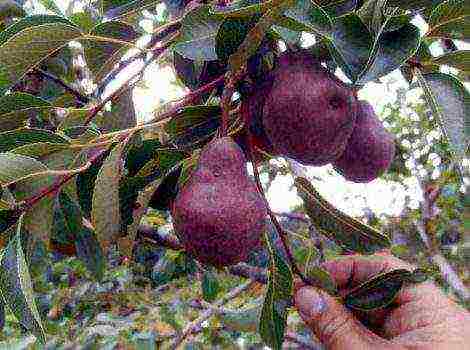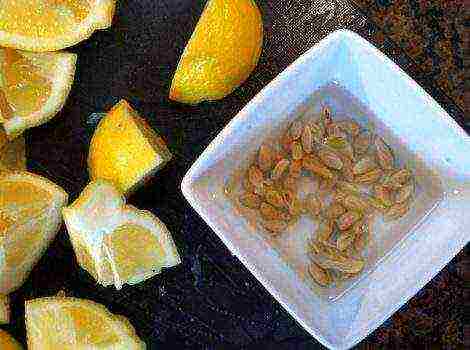Content
Effective Pine Nut Harvesting Methods
Pine nuts are known not only in Siberia and the Far East, but also far beyond their borders. However, the main place for storing nuts occurs precisely in the Siberian taiga.
Most of the cedar massifs grow on the stony placers of Eastern Siberia, in the west, as well as in the mountainous regions of Southern Siberia. In these regions, picking pine nuts is an important fishery for the population. After all, Siberian pine seeds are a valuable food product.
When do pine nuts ripen in Siberia?
Siberian cedar is a wind-pollinated plant that has male and female inflorescences on the same tree. Brightly crimson shoots of male cones, located at the base of the growth in the middle of the tree. Female cones with shoots are at the top of the crown. The flowering period takes place in late May - early June. It takes 18 months from the moment of bud formation at the top of the shoot until the seeds ripen. Nuts begin to ripen at different times. The ripening time of pine nuts can be divided into several periods:
- In the embryonic spring-summer period, the formation of ovules, their flowering and pollination occurs. With the onset of warm summer, cross-pollination and seed formation occurs.
- After pollination, the ovules become resinous and store pollen in themselves for 11-12 months. Reaching a size of 1.5 - 2 cm in length, the ovules take the shape of a cedar cone. Overwintered cones are called winter cones.
- Winter cones grow intensively and by July they reach 5-7 cm... The cover turns into a shell. A bulge appears. The yellow color changes to reddish brown. Shape, color and size may vary depending on the age of the tree and weather conditions.
- In September, the ripening period of the nuts ends. Dark brown buds with an oily core (up to 79.5% oil) become dry, not resinous and light. The seeds are detached from the cone scales. Mature cones are easily torn off the trees by gusts of wind or impact on the trunk.
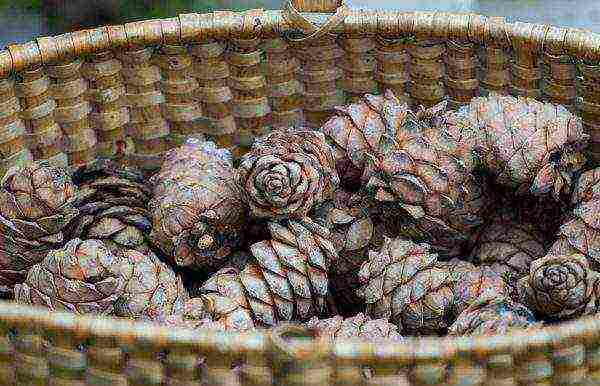
The period of maturity begins in mid-August - early September. In mountainous areas, ripening occurs later. Ripening dates can be shifted by 1-2 weeks in one direction or another. The ripeness of nuts in different areas, the quantity and quality of future harvests are determined by the following factors:
- geographic location;
- features of the relief - lowlands, plains, slopes, mountain heights;
- growing conditions, the origin of the stand, the qualitative composition of forests;
- soil composition of lands;
- age of trees;
- weather conditions.
It is the last factor that largely determines the ripening time of the nuts, and also affects the yield. With the onset of early spring, cedar blooms in early - mid June. With the arrival of late spring - flowering occurs at the end of the month.
In favorable warm and relatively dry weather, pollination begins in a few days. In case of bad weather, it is postponed for 2 weeks. At this time, the formation of the crop takes place. With a rainy, cold summer, the growth of cones of the current year slows down, they become resinous, one-sided. The cold start of summer negatively affects the yield of the next two years.
Due to incomplete pollination, the number of empty seeds increases, having a negative effect on the development of primordia. Too hot summer promotes resinification, negatively affecting winter crops.
Cedar trees do not have a consistent seed yield.The dynamics of yields of cedar trees can differ significantly both in different areas and within the same plantation. Cedar pine bears fruit every two years. Medium and high yields are in 4-8 years. For a tree to burst with fruits, this happens extremely rarely - once every 10-15 years.
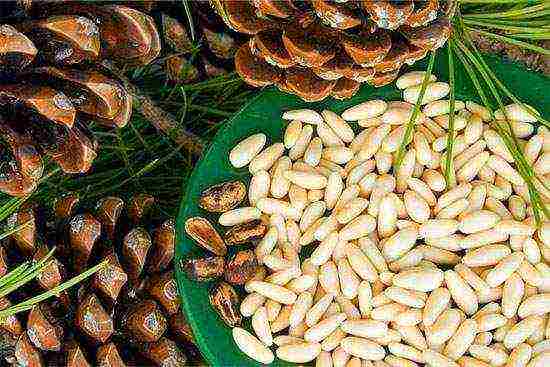
When are pine nuts harvested?
Traditionally, the season for picking pine nuts begins in early September, and in mountainous areas in the middle of the month. However, most often the extraction of walnuts is carried out in Siberia. In strong winds, ripe buds on the tops of the trees will easily peel off and fall off. Having rolled on the slopes, they usually roll into heaps. Fallen cones are called pads.
Collecting cones also begins when, when struck with a punch or shaking the branches, the fruits fall off. Unscrupulous pickers begin to knock down the cones before they are fully ripe, thereby harming the forage base of forest animals and birds. Therefore, local authorities officially set the dates for the collection of pine nuts.
Violation of the rules will result in a fine.
For the local population, the timing of collecting cedar fruits is limited, since the hunting season begins next. The harvesting season ends after the first snow appears. But, it can also be carried out with snowfall, depending on weather conditions and the thickness of the snow cover. The autumn season ends in late September - early October. Finishing to shoot down and collect the cones, they begin to process them.
In addition to the autumn harvest, there is also a spring one. From April to May, depending on the weather, padanok cones are harvested.
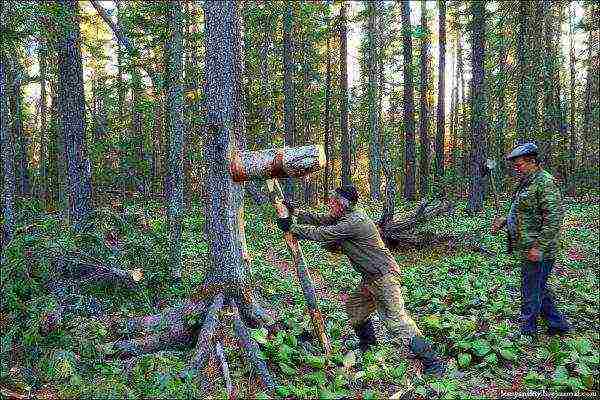
How are pine cones harvested?
Procurement of nuts is a laborious and multi-stage process. Therefore, several people are involved in the fishery. Lost in a cooperative, they leave for the taiga for weeks. Camp is set up in the forest and temporary shelter is erected. Arrange a place for storing, peeling and sifting cones.
In search of fertile trees, sometimes you have to walk distances, follow the footsteps of wild animals. After all, they are the ones who better feel where the yielding cedar trees are.
Cedar fruits are collected in several ways:
- They pick up padanki fallen by gusts of wind. In this way, they do not harm nature. However, most of the buds are scattered by wild animals, and the drop of the buds is not uniform.
- Climbing trees. The picker climbs up the tree trunk and, with the help of a long pointed rod with a hook, hits the branches, knocking down the cedar cones. They also knock cones off the branches using girders - long, flexible poles. This collection method is dangerous and less effective. The fallen cones are picked up and put in a bucket.
- Claw climbing method... Claws are special shoes with sharp iron spikes that make it easier to climb a tree. Additional insurance is provided by a rope that wraps around the tree trunk. Holding on to both ends of the rope, the person is in the same plane with the trunk, ensuring quick climbing and safety.
- A well-known method is knocking down cones using a log hammer - punch. Observing certain rules, a worker hits a tree trunk with a giant hammer. From a few blows, the trunk and branches begin to vibrate. The cones come off with a characteristic noise. If the cones crumble weakly, ropes or reins are tied to the stab, one on each side. Two people, at the moment of impact, pull them back. After such a reception, mature cones fall like hail. At this moment, the main thing is to dodge.For a person, this method is safe, and beneficial in terms of the ratio of the time spent and the harvest. On the other hand, knocking down cones with a punch damages the trunk and bark of the tree, thereby causing damage. Experienced craftsmen hammer the trunk of a tree with a punch on only one side, so that the wounds can be baked with resin for the next harvest. After knocking down, collect the fallen cones in special gloves (tops) and put them in bags.
In the camp, the harvested crop is passed through a drum or a special grater, consisting of a roll and teeth. Cones are crushed and flaked. After sifting through a sieve and winnowing. Dried crops in the camp. The dryer is made of a wooden frame. An iron sheet with small holes is attached on top. Peeled nuts are poured onto the sheet. A low fire is maintained in the inner part of the log house. Dry the nuts, stirring constantly. Overheated nuts lose their beneficial properties, so it is best to dry the crop in the sun.
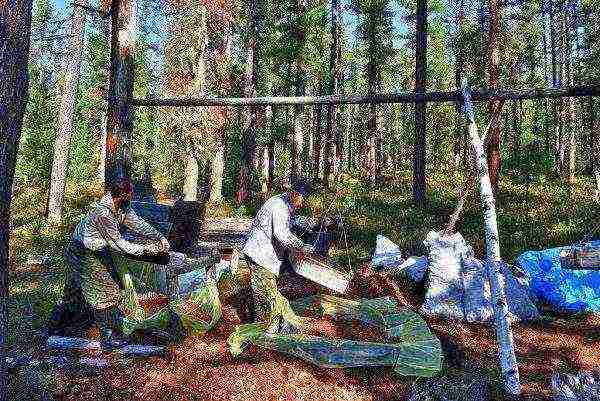
How to make a cleaver for the extraction of pine nuts and how much does it weigh?
In the cedar industry, it is difficult to do without chipping. Having a simple structure, you can make the chisel yourself. The tool consists of a striker (block) 65-80 cm long, 25-35 cm in diameter and a leg (cutting) 2-2.5 m long. The block is made from the butt part of a young birch or larch. In the lower part of the trunk they make a dovetail cut. It is important that the handle goes through the center of the firing pin.
It was washed down at an angle so that the handle with the striker could hold without the use of nails. The striker must be perpendicular to the base of the cleaver. This facilitates striking after it has passed the balance point. The weight and length of the chisel largely depend on the physical fitness of the worker and the quality characteristics of the trees. The harder the punch, the better the knocking effect. How much does he weigh? Weight varies from 20 to 70 kg.
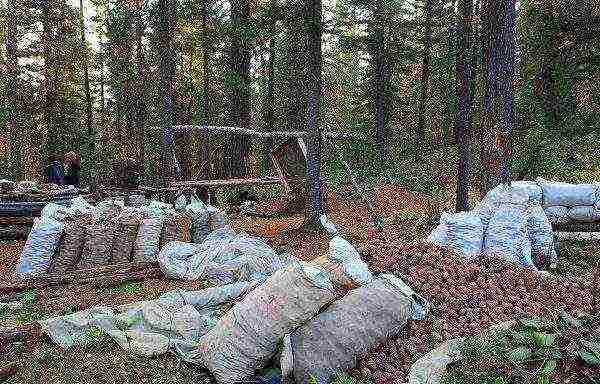
The following tips will help you make a stab yourself:
- In cedar forests with massive trees, a heavier chipper is used. For tall cedars, the stalk is lengthened.
- Many people prefer to make the firing pin from larch. It is durable and does not rot. From it, the chisel can be used for 2-3 years, changing only the stalk.
- The base is made of dry cedar, as it is softer to the touch and more comfortable to hold when hitting.
- Usually the base of the cleaver is attached to the striker at a right angle. Having made at an inclination of 10-15 degrees from a right angle, the blow will turn out to be stronger. By placing the hammer farther from the barrel, when hitting, the striker has a larger swing, and the inclination helps to increase the force of the impact.
When making a chisel, fishermen try to take into account many features in the creation of an instrument, as well as to improve the technique of striking. After all, the efficiency of the harvest depends on this. Cedar harvest is an important craft for the peoples of Siberia. Every year, in September, the cedar harvest season opens. Whole families participate in the collection. After all, pine nuts are unusually rich in oil, vitamins and proteins. Unpeeled nuts can be stored for a long time, but husked nuts quickly deteriorate and rot. Therefore, it is important to start fishing at the right time, observing all the rules for collecting nuts.
